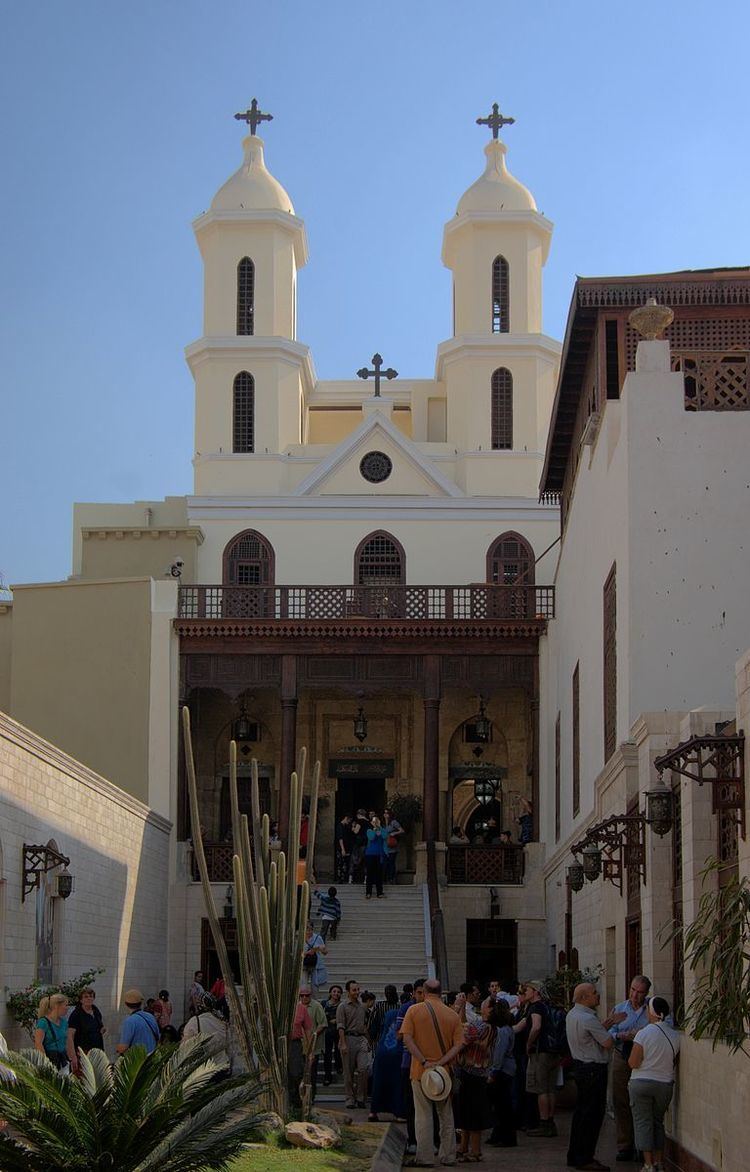Location Babylon, Egypt Architectural style Coptic architecture Dedication Mary | Priest(s) Fr. Jacob Soliman Founded 3rd century | |
 | ||
Bishop(s) Pope Tawadros II
Bishop Selwaniss Address Kom Ghorab, Misr Al Qadimah, Cairo Governorate, Egypt Diocese Coptic Orthodox Church of Alexandria Similar Ben Ezra Synagogue, Babylon Fortress, Coptic Cairo, Coptic Museum, Khan el‑Khalili | ||
Islam in coptic cairo koran in the background at the hanging church
Saint Virgin Mary's Coptic Orthodox Church (Coptic: Ⲉⲕⲕⲗⲏⲥⲓⲁ ⲛⲧⲉⲙⲁⲥⲛⲟⲩⲧ) also known as the Hanging Church (Egyptian Arabic: الكنيسة المعلقة El Muallaqa, Coptic: Ⲉⲕⲕⲗⲏⲥⲓⲁ ϫⲓⲛⲓⲱⲓ) is one of the oldest churches in Egypt and the history of a church on this site dates to the 3rd century AD.
Contents
- Islam in coptic cairo koran in the background at the hanging church
- Virgin mary church the hanging church with light
- Importance
- Seat of Coptic Pope
- Holy icons
- References
The Hanging (The Suspended) Church is named for its location above a gatehouse of Babylon Fortress, the Roman fortress in Coptic Cairo (Old Cairo); its nave is suspended over a passage. The church is approached by twenty-nine steps; early travelers to Cairo dubbed it "the Staircase Church." The land surface has risen by some six metres since the Roman period so that the Roman tower is mostly buried below ground, reducing the visual impact of the church's elevated position. The entrance from the street is through iron gates under a pointed stone arch. The nineteenth-century facade with twin bell towers is then seen beyond a narrow courtyard decorated with modern art biblical designs. Up the steps and through the entrance is a further small courtyard leading to the eleventh-century outer porch.
Virgin mary church the hanging church with light
Importance
The Hanging Church is the most famous Coptic Christian church in Cairo, as well as possibly the first built in Basilican style. It was probably built during the patriarchate of Isaac (690–692), though an earlier church building may have elsewhere existed dating as early as the 3rd or 4th century. However, the earliest mention of the church was a statement in the biography of the patriarch Joseph I (831–849), when the governor of Egypt visited the establishment. The church was largely rebuilt by the Pope Abraham (975–978) and has seen many other restorations including an extensive repair and restoration of the church and its surroundings completed in 2011. Objects of historical interest that were no longer of service went to the Coptic Museum.
The church is the site of several reported apparitions of Mary. She is said to have appeared in a dream to the Coptic Pope Abraham in the 970s AD in the story of how the Muqattam Mountain was moved by faith. (See the articles on Pope Abraham and on Saint Simon the Tanner.)
Seat of Coptic Pope
The Seat of the Coptic Orthodox Pope of Alexandria was, historically, Alexandria, Egypt. But as ruling powers moved away from Alexandria to Cairo after the Arab invasion of Egypt during Pope Christodolos's tenure, Cairo became the fixed and official residence of the Coptic Pope at the Hanging Church in 1047.
Infighting between the Church of Saints Sergius and Bacchus and the El Muallaqa Church broke out due to the wishes of that patriarch's desire to be consecrated in the Hanging Church, a ceremony that traditionally took place at Saints Sergius and Bacchus.
Holy icons
The Hanging Church has 110 icons, the oldest of which dates back to the 8th century, but most of them date to the 18th century. Nakhla Al-Baraty Bey gave some of them as gifts, in 1898, when he was the overseer of the church. The iconostasis of the central sanctuary is made of ebony inlaid with ivory, and is surmounted by icons of the Virgin Mary and the Twelve Apostles. The main altar (Egyptian Arabic: haikal) screen is made of ebony inlaid with ivory that is carved into segments showing several Coptic Cross designs that date back to around the 12th or 13th century. Over the altar screen lies a long row of seven large icons, the central one of which is Christ seated on the Throne. On one side, the icons of the Virgin Mary, Archangel Gabriel and St Peter are lined up. On the other, icons of St. John the Baptist, Archangel Michael and St. Paul.
